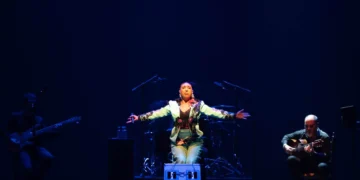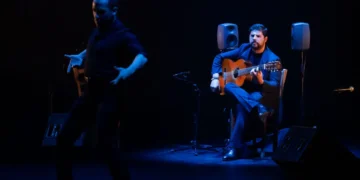|
‘AMOR BRUJO’ |
|
SPECIAL BIENAL DE FLAMENCO DE SEVILLA 2008 Text: Gonzalo Montaño Peña Seville’s Maestranza theater filled to capacity for the show “Amor Brujo” presented by the Real Orquesta Sinfónica de Sevilla” with the special collaboration of Esperanza Fernández. A work composed by the great Manuel de Falla, one of the central pieces of flamenco music, for dancer Pastora Imperio and premiered at the Teatro Lara in Madrid in 1915. Now, nearly a hundred years later, another gypsy came to put the racial flamenco touch to the symphonic work. The first part of the concert was dedicated to the entire string section of the symphonic orchestra who interpreted “La Oración del Torero” by Joaquín Turina, followed by two cello quartets who played “Fandango Para Ocho Violoncellos” by Cristóbal Halfter. The second part opened with “Taqsim”, a somewhat dream-like work, created by the Algeciras composer José María Sánchez Verdú with North African influences. After these musical aperitifs, Esperanza Fernández appeared on stage, elegantly dressed in black, with mantilla, to take her place between the director and the first violin. She is received with warm applause and “El Amor Brujo” begins. The singer began seated, with her eyes closed, concentrated, waiting for her turn in a work which she has already interpreted and also recorded previously. After an orchestral introduction, comes “Canción del Amor Dolido”, the singer’s first intervention, where her perfectly tuned voice moves staccato-like between resonating strings, and flamenco sounds give form to the unfolding story. She not only sings, but acts as narrator, gesturing as the star tries to find a cure for her love-sickness in a witches’ cave. But it’s the “Canción del Fuego Fatuo”, perhaps the best-known fragment of “Amor Brujo”, where the singer is the most flamenco and gypsy, dancing, hardly moving from the spot, with tremendous elegance, while her voice reminds us that “Lo mismo que el fuego fatuo, lo mismito es el querer” (‘love is exactly like a fatuous flame’) After this lovely passage came the “Danza del Juego del Amor” with the orchestra full-blast, as Esperanza reveals the dénouement of this fatal love story that ends with “Las Campanas del Amanecer”. The audience started out a bit cold, but warmed up little by little with the “Amor Brujo”, possibly because many were there more for the flamenco connection than the symphonic one. By the same token, Esperanza showed what a versatile performer she is, putting her voice at the service of many different kinds of music, although as I said, we already knew this lyrical facet of hers, although when required, she would also recite and act with great natural ease, which reinforces her artistic reputation. |
Descubre más desde Revista DeFlamenco.com
Suscríbete y recibe las últimas entradas en tu correo electrónico.


 XV BIENAL DE FLAMENCO DE SEVILLA
XV BIENAL DE FLAMENCO DE SEVILLA























